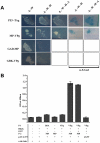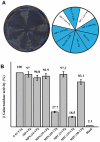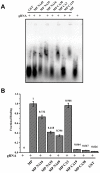Interaction of Sesbania mosaic virus movement protein with VPg and P10: implication to specificity of genome recognition
- PMID: 21246040
- PMCID: PMC3016346
- DOI: 10.1371/journal.pone.0015609
Interaction of Sesbania mosaic virus movement protein with VPg and P10: implication to specificity of genome recognition
Abstract
Sesbania mosaic virus (SeMV) is a single strand positive-sense RNA plant virus that belongs to the genus Sobemovirus. The mechanism of cell-to-cell movement in sobemoviruses has not been well studied. With a view to identify the viral encoded ancillary proteins of SeMV that may assist in cell-to-cell movement of the virus, all the proteins encoded by SeMV genome were cloned into yeast Matchmaker system 3 and interaction studies were performed. Two proteins namely, viral protein genome linked (VPg) and a 10-kDa protein (P10) c v gft encoded by OFR 2a, were identified as possible interacting partners in addition to the viral coat protein (CP). Further characterization of these interactions revealed that the movement protein (MP) recognizes cognate RNA through interaction with VPg, which is covalently linked to the 5' end of the RNA. Analysis of the deletion mutants delineated the domains of MP involved in the interaction with VPg and P10. This study implicates for the first time that VPg might play an important role in specific recognition of viral genome by MP in SeMV and shed light on the possible role of P10 in the viral movement.
Conflict of interest statement
Figures








Similar articles
-
Interaction of Sesbania mosaic virus (SeMV) RNA-dependent RNA polymerase (RdRp) with the p10 domain of polyprotein 2a and its implications in SeMV replication.FEBS Open Bio. 2014 Mar 29;4:362-9. doi: 10.1016/j.fob.2014.03.009. eCollection 2014. FEBS Open Bio. 2014. PMID: 24918050 Free PMC article.
-
Interaction of Sesbania mosaic virus movement protein with the coat protein--implications for viral spread.FEBS J. 2011 Jan;278(2):257-72. doi: 10.1111/j.1742-4658.2010.07943.x. Epub 2010 Dec 1. FEBS J. 2011. PMID: 21122074
-
Complete nucleotide sequence of Sesbania mosaic virus: a new virus species of the genus Sobemovirus.Arch Virol. 2001;146(2):209-23. doi: 10.1007/s007050170170. Arch Virol. 2001. PMID: 11315633
-
The genome-linked protein VPg of plant viruses-a protein with many partners.Curr Opin Virol. 2011 Nov;1(5):347-54. doi: 10.1016/j.coviro.2011.09.010. Epub 2011 Oct 14. Curr Opin Virol. 2011. PMID: 22440836 Review.
-
The genome-linked protein VPg of vertebrate viruses - a multifaceted protein.Curr Opin Virol. 2011 Nov;1(5):355-62. doi: 10.1016/j.coviro.2011.09.003. Epub 2011 Oct 7. Curr Opin Virol. 2011. PMID: 22440837 Free PMC article. Review.
Cited by
-
Intrinsically disordered proteins of viruses: Involvement in the mechanism of cell regulation and pathogenesis.Prog Mol Biol Transl Sci. 2020;174:1-78. doi: 10.1016/bs.pmbts.2020.03.001. Epub 2020 Apr 2. Prog Mol Biol Transl Sci. 2020. PMID: 32828463 Free PMC article. Review.
-
Interaction of Sesbania mosaic virus (SeMV) RNA-dependent RNA polymerase (RdRp) with the p10 domain of polyprotein 2a and its implications in SeMV replication.FEBS Open Bio. 2014 Mar 29;4:362-9. doi: 10.1016/j.fob.2014.03.009. eCollection 2014. FEBS Open Bio. 2014. PMID: 24918050 Free PMC article.
-
Sesbania mosaic virus (SeMV) infectious clone: possible mechanism of 3' and 5' end repair and role of polyprotein processing in viral replication.PLoS One. 2012;7(2):e31190. doi: 10.1371/journal.pone.0031190. Epub 2012 Feb 15. PLoS One. 2012. PMID: 22355344 Free PMC article.
-
Overview on Sobemoviruses and a Proposal for the Creation of the Family Sobemoviridae.Viruses. 2015 Jun 15;7(6):3076-115. doi: 10.3390/v7062761. Viruses. 2015. PMID: 26083319 Free PMC article. Review.
References
-
- Scholthof HB. Plant virus transport: motions of functional equivalence. Trends Plant Sci. 2005;10:376–382. - PubMed
-
- Dolja VV, Haldeman-Cahill R, Montgomery AE, Vandenbosch KA, Carrington JC. Capsid protein determinants involved in cell-to-cell and long distance movement of tobacco etch potyvirus. Virology. 1995;206:1007–1016. - PubMed
-
- Rojas MR, Zerbini FM, Allison RF, Gilbertson RL, Lucas WJ. Capsid protein and helper component-proteinase function as potyvirus cell-to-cell movement proteins. Virology. 1997;237:283–295. - PubMed
Publication types
MeSH terms
Substances
LinkOut - more resources
Full Text Sources
Miscellaneous

